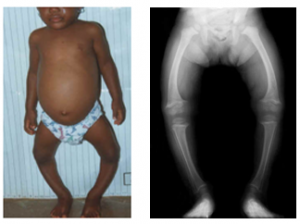Dr. Vijay R. Kakatkar,
M.S (Ortho), D. Ortho. (BOM), Consulting Orthopaedic Surgeon,
Ramkrishna Medical Research Centre & Jai Hospital, Nashik
Introduction:
Vitamin D, also known as the sunshine Vitamin, can be produced in the body with mild sun exposure or consumed in food or supplements. India being tropical country with lot of sunlight round the year, Vitamin D deficiency was thought to be very rare amongst Indians. But it is not so. We have a large population of all age groups having Vitamin D deficiency with varied clinical presentation.
Adequate Vitamin D intake is important for the regulation of calcium and phosphorus absorption, maintenance of healthy bones and teeth, and is suggested to supply a protective effect against multiple diseases such as cancer, diabetes.
Vitamin D deficiency is frequently documented because of lack of exposure to sunlight, high level of pollution and increased rate of detection.
Recent studies have suggested that up to 50% of adults and children worldwide are Vitamin D deficient.
In spite of the name, Vitamin D is considered a pro-hormone and not actually a Vitamin. This is because the body is capable of producing its own Vitamin D through the action of sunlight on the skin, while Vitamins are nutrients that cannot be synthesized by the body and must be acquired through the diet or supplements.
Role of Vitamin D :
Vitamin D has multiple roles in the body, helping to:
- Maintain the health of bones and teeth
- Support the health of the immune system, brain and nervous system
- Regulate insulin levels
- Support lung function and cardiovascular health
- Influence the expression of genes involved in cancer development.
Vitamin D synthesis in the body
Vitamin D is produced when sunlight converts cholesterol on the skin into calciferol(Vitamin D3). Vitamin D3 is then converted into calcidiol (25-hydroxyVitamin D3) in the liver. The kidneys then convert calcidiol into the active form of Vitamin D, called calcitriol (1,25-hydroxyVitamin D3). As such, statins and other medications or supplements that inhibit cholesterol synthesis, liver function or kidney function can impair the synthesis of Vitamin D.
Deficiency of Vitamin D
sun exposure on bare skin for 5-10 minutes 2-3 times per week allows the body the ability to produce sufficient Vitamin D, but Vitamin D has a half-life of only two weeks, meaning that stores can run low, especially in winter.
- A fair-skinned person with full body exposure to the sun can synthesize up to 20,000 IU of Vitamin D3 in 20 minutes.
- Vitamin D deficiency is common, especially in the elderly, infants, people with dark skin and people living at higher latitudes or who get little sun exposure.
- Darker skin pigments and sunscreen use can significantly decrease the body’s ability to absorb the ultraviolet radiation B (UVB) rays required to produce Vitamin D.
- A sunscreen with sun protection factor (SPF) 30 can reduce the body’s ability to synthesize the Vitamin by 95%. The skin also has to be directly exposed to the sunlight, not covered by clothing, in order to start Vitamin D production. Even the angle at which sunrays hit the earth can affect absorption.
- People who live in northern latitudes or areas of high pollution, work at night and stay home during the day or are homebound
- Infants who are exclusively breastfed are also at high risk of Vitamin D deficiency, especially if they are dark-skinned or have minimal sun exposure.
- The metabolism of Vitamin D may be affected by some medications, including barbiturates, phenobarbital, dilantin, isoniazid and statin drugs.
Health benefits of Vitamin D
1) Vitamin D for healthy bones
Vitamin D plays a substantial role in the regulation of calcium and maintenance of phosphorus levels in the blood, two factors that are extremely important for maintaining healthy bones. We need Vitamin D to absorb calcium in the intestines and to reclaim calcium that would otherwise be excreted through the kidneys.
Vitamin D deficiency in children can cause rickets, a disease characterized by a severely bow-legged appearance triggered by impaired mineralization and softening of the bones.
In adults, Vitamin D deficiency manifests as osteomalacia or osteoporosis. Osteomalacia results in poor bone density, muscular weakness and often causes small pseudo fractures of the spine, femur and humerus. Osteoporosis is the most common bone disease among post-menopausal women and older men.
Vitamin D deficiency has been seen in up to 80% of hip fracture patients.
800IU of Vitamin D per day reduces the risk of fracture by 20% in the elderly
2) Reduced risk of flu
Children given 1,200 IU of Vitamin D per day for 4 months during the winter reduced their risk of influenza A infection by over 40%.2
3) Reduced risk of diabetes
Several observational studies have shown an inverse relationship between blood concentrations of Vitamin D in the body and risk of diabetes. In diabetics, insufficient Vitamin D levels may have an adverse effect on insulin secretion and glucose tolerance
4) Healthy pregnancy
Pregnant women who are deficient in Vitamin D seem to be at greater risk of developing preeclampsia
5) Cancer prevention
Vitamin D is important for regulating cell growth and for cell-to-cell communication. Some studies have suggested that calcitriol (the hormonally active form of Vitamin D) can reduce cancer progression by slowing the growth and development of new blood vessels in cancerous tissue, increasing cancer cell death and by reducing cell proliferation and metastases.
6) Vitamin D and weight loss
Researchers at the University of Minnesota found that Vitamin D levels in the body at the start of a low-calorie diet predict weight loss success, suggesting a possible role for Vitamin D in weight loss.
Recommended intake of Vitamin D
Vitamin D intake can be measured in two ways: in micrograms (mcg) and International Units (IU). One microgram of Vitamin D is equal to 40 IU of Vitamin D. The recommended intakes of Vitamin D throughout life were updated by the US Institutes of Medicine (IOM) in 2010 and are currently set at:
- Infants 0-12 months – 400 IU (10 mcg)
- Children 1-18 years – 600 IU (15 mcg)
- Adults to age 70 – 600 IU (15 mcg)
- Adults over 70 – 800 IU (20 mcg)
- Pregnant or lactating women – 600 IU (15 mcg).
- Vitamin D is fat soluble, meaning that its absorption requires dietary fat. In addition, magnesium is needed to convert Vitamin D into its active form.
Vitamin D food sources
Sunlight is the most common and efficient source of Vitamin D. The richest food sources of Vitamin D are fish oil and fatty fish.
- Cod liver oil, 1 tablespoon: 1,360 IU
- Fortified skim milk, 1 cup: 120 IU
- Egg, chicken, whole large: 44 IU.
Potential health risks of consuming Vitamin D
The Upper Level (UL) limit recommended for Vitamin D is 4000 IU per day. However, the National Institutes of Health (NIH) has suggested that Vitamin D toxicity is unlikely at daily intakes below 10,000 IU/day.
Excessive consumption of Vitamin D can lead to the over calcification of bone and the hardening of blood vessels, kidney, lungs and heart. The most common symptoms of hyperVitaminosis D are headache and nausea but can also include loss of appetite, dry mouth, a metallic taste, vomiting, constipation, and diarrhoea.
My experience with Vitamin D:
In my 40 years of practice as an orthopaedic surgeon, I have observed varied clinical presentations of Vitamin D deficiency
Paediatric age group : typical rickets picture of pot belly, faulty dentition, bowing of legs was observed.
Young adults : many adults had vague complaints of neck / back / generalised body pain which was initially accounted to faulty posture and lack of exercise. In such patients improvement of posture and adequate physiotherapy did not lead to clinical improvement. On further investigations most of them were found to be Vitamin D deficient. When treated for the same they showed satisfactory improvement.
Post partum females: presented with pain and waddling gait because of Vitamin D deficiency leading to osteomalacia.
Elderly : Majority of the patients of osteoporotic fractures who were further investigated showed low levels of Vitamin D. Supplementation with Vitamin D along with routine treatment protocol lead to better post operative results














